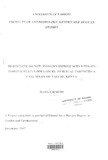| dc.contributor.author | Gichuhi, Mary | |
| dc.date.accessioned | 2013-05-09T12:24:25Z | |
| dc.date.issued | 2007 | |
| dc.identifier.citation | Master of Arts | en |
| dc.identifier.uri | http://erepository.uonbi.ac.ke:8080/xmlui/handle/123456789/20862 | |
| dc.description.abstract | The prevention and control of HIV infection depends on the success of strategies to
prevent new infections and treat currently infected individuals. Within HIV testing and
counseling programmes emphasis is placed on the importance of HIV status disclosure
among HIV infected clients, particularly to sexual partners. Disclosure may motivate
, sexual partners to seek testing, change behaviour and ultimately decrease transmission of
HIV. In addition, disclosure may facilitate other health behavious that may improve the
management of HIV. For example, women who disclose their status to partners may me
more likely to participate in programmes for prevention of HIV transmission from
mothers to their infants. Through disclosure of her status, a woman may receive support
from her family or others in her social network andmay also be able to access available
support services. It has been recognized however, that there are a number of barriers that
HIV infected women may face in sharing their test result with sexual partners. This report
aims to identify the major barriers and outcomes of HIV positive disclosure to sexual
partners. In addition, women's experiences with HIV positive status disclosure to sexual
partners is documented and the support mechanisms they employ in order to disclose
their disclose their status with minimal negative consequences reviewed. The report ends
with a section on recommendations for ways to move forward to increase disclosure rates
among women to their sexual partners. . | en |
| dc.description.sponsorship | University of Nairobi | en |
| dc.language.iso | en | en |
| dc.publisher | University of Nairobi | en |
| dc.subject | HIV | en |
| dc.subject | Kenya | en |
| dc.subject | Women | en |
| dc.title | To disclose or not: women's experiences with HIV- positive Status disclosure to sexual partners: a Case study of Nakuru, Kenya | en |
| dc.type | Thesis | en |
| local.publisher | Faculty of Arts, University of Nairobi,Kenya | en |

